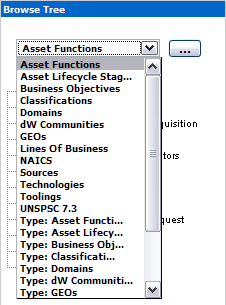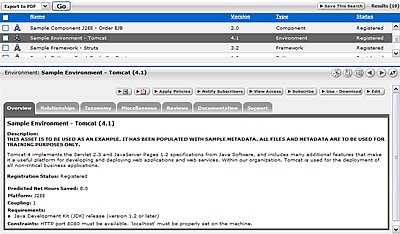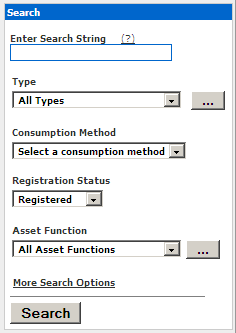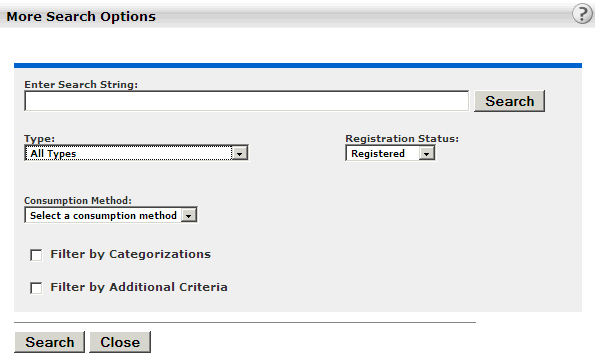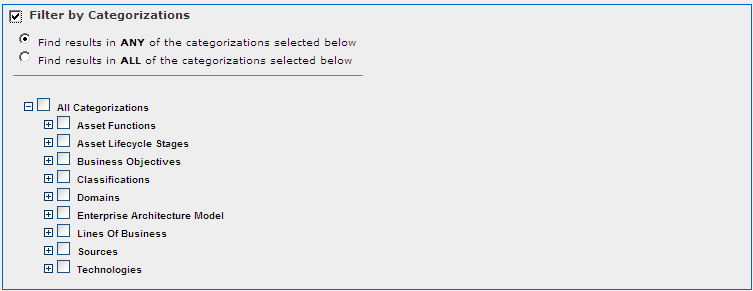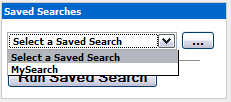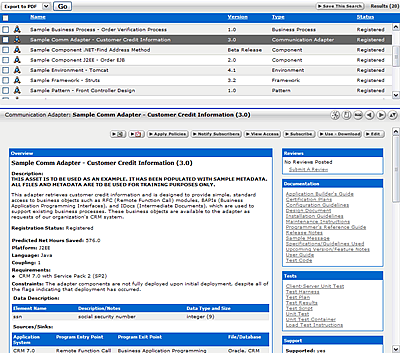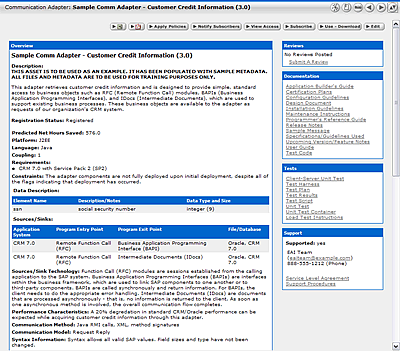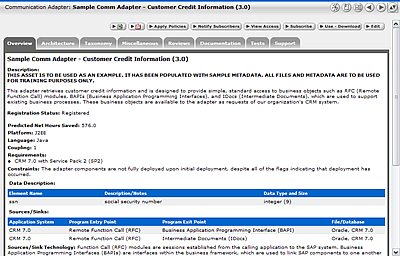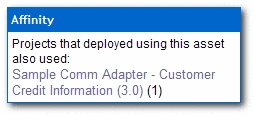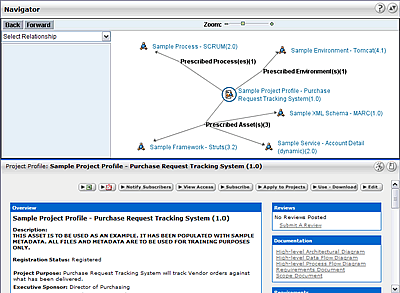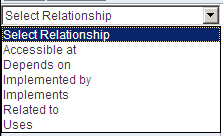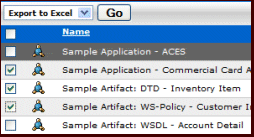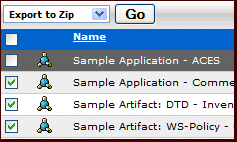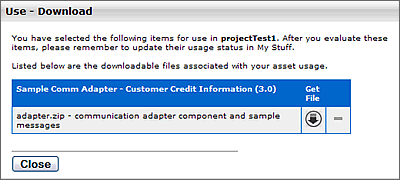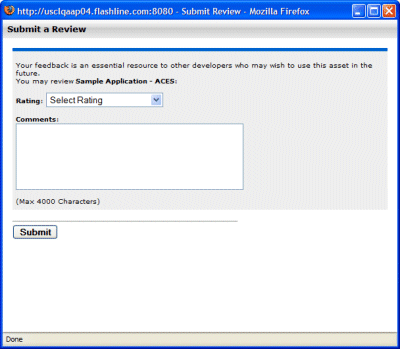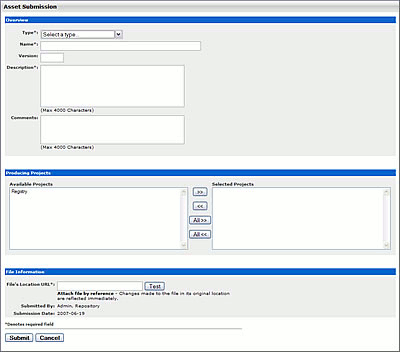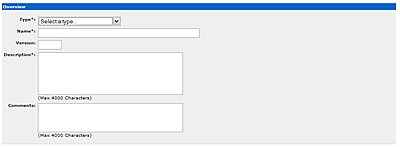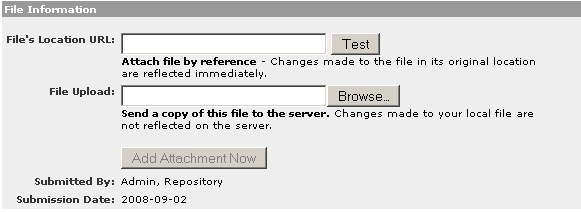1 Oracle Enterprise Repository
This chapter describes how to use Oracle Enterprise Repository for governance and describes roles, assets, projects, and reports.
This chapter includes the following sections:
1.1 Overview
Governance must address the control and management of entire business processes, trace the relationship of services to other assets in the enterprise, and show how the collection of these elements in a service-oriented architecture (SOA) has a direct impact on the effectiveness of the business itself. The combination of Oracle Enterprise Repository and Service Registry, Oracle Web Service Manager, and Oracle Management Pack for SOA forms the technology foundation for SOA governance throughout the SOA lifecycle.
The Oracle Enterprise Repository provides the following value to customers:
-
Visibility into all SOA assets and their relationships
-
Automatically collects and populates the Oracle Enterprise Repository and Registry with existing services and other assets through introspection and synchronization with developer tools.
-
Provides a flexible and extensible model for categorizing SOA assets.
-
Provides visibility of assets that currently exist, are planned, or are in development to reduce duplication of effort.
-
Automatically discovers, maps, and manages new dependencies to support impact analysis.
-
-
End-to-end governance throughout the lifecycle
-
Automates repeatable processes for registration and lifecycle management through out-of-the-box workflows based on best practices.
-
Provides visibility into policies throughout the lifecycle to promote trust in service quality, performance, and security.
-
Communicates architectural standards and tracks architectural compliance.
-
-
Analytics
-
Tracks and reports on reuse throughout the entire service lifecycle, including development reuse, run-time service reuse statistics, and data on consumption and compliance through scorecards.
-
Collects and communicates vital information on service performance, quality, and compliance with corporate standards.
-
Supports critical decisions with feedback on SOA compliance, performance, and ROI.
-
1.2 Getting Started
This section describes the following best practice processes:
1.2.1 Logging in to Oracle Enterprise Repository
To log in to Oracle Enterprise Repository, perform the following steps:
-
Using a browser, open Oracle Enterprise Repository.
-
On the login screen, enter the appropriate information in the Username and Password boxes.
Note:
If your organization requires a user name and password each time you log in to Oracle Enterprise Repository, ensure that the Enable Automatic Login box is unchecked.
-
Click Login. The Login Status dialog displays a welcome message that includes the date and time of your login.
-
In the Login Stats dialog, click Close.
1.2.2 The Default View
After you have logged in, you will see the Oracle Enterprise Repository home page, as shown in Figure 1-1. This page can be customized by the system administrator to display resources, assets, and news relevant to your company.
Figure 1-1 Oracle Enterprise Repository Home Page

Description of "Figure 1-1 Oracle Enterprise Repository Home Page"
The Oracle Enterprise Repository Menu Bar
The Oracle Enterprise Repository menu bar runs across the top of the console, and enables you to navigate to the various tools and features within Oracle Enterprise Repository.
The actual links that appear in the menu bar are determined by the permissions granted to your specific role. These links point to corresponding Oracle Enterprise Repository screens, each with specific features and functionality, including:
-
Assets
Click to use, submit, edit, and manage assets, as determined by the access settings for your assigned role.
-
Projects
Visible and accessible only to users in the appropriate role.
Click to create, manage, and search for projects, and to assign users to projects.
-
My Stuff
Click to view information about assets you have produced or consumed, assets that are assigned to you for review and approval, projects to which you are assigned, your saved searches, or assets to which you have subscribed.
-
Reports
Click to view a number of standard reports based on asset usage, value, and compliance. You can create your own custom reports using the reporting tool of your choice. Custom reports can be added to the Reports page.
-
Admin
-
Visible and accessible only to users in the appropriate role.
-
Enables system configuration after installation, and is used to create users, assign roles, configure access settings, configure system and email settings, and monitor system use.
-
-
Custom Links
-
No longer displayed by default.
-
You can configure these additional custom links using the following method:
-
Open the Oracle Enterprise Repository home page.
-
Click the Admin menu, then System Settings option.
-
Enter link in the Search field. The Functional Settings pane is displayed with a list of all the custom links that you can configure.
-
Click True to enable the display of the custom links.
-
-
-
Repository Request
Click to submit requests to the designated registrar, such as a request for an asset that is unavailable in the registry.
-
Help
Provides general information about using Oracle Enterprise Repository.
The Oracle Enterprise Repository Home page can be customized to highlight your company's news and policies. This page includes embedded features that display information about new additions to the repository, the most frequently used assets, and a list of users who have achieved the highest levels of asset reuse. As an alternative, your company can substitute its own home page. In addition, you can create different Home pages that can be displayed based on the user's role. In this way, Business Analysts can see a different set of information than Architects or Development resources. Think of this page as a configurable portal that enables your organization to promote initiatives to all Oracle Enterprise Repository users.
Note:
These custom home pages require users to have some exposure to JSP or HTML development as well as the application server's deployment and properties files in order to effectively configure this feature.
1.2.3 Logging Out of Oracle Enterprise Repository
The login indicator, located in the bottom right corner of any Oracle Enterprise Repository page, indicates the user name under which you are currently logged in. A logout link is also provided.
To log out:
-
Click Logout. A confirmation message appears.
-
Exit the browser, or click Log back in.
1.3 User Role Descriptions
Oracle Enterprise Repository users are defined by roles. Each role has certain permissions that enable users to fulfill specific tasks.
The default roles shipped with Oracle Enterprise Repository are described below. (The Admin page, visible only to users with the appropriate access settings, enables the names of these roles to be changed to suit organizational needs. The Admin page also provides the means to change Access Settings.)
-
User
-
Anyone with an Oracle Enterprise Repository user name and password is considered to be a user. This role can be assigned as the default role for any new users at the time the user is created. All Oracle Enterprise Repository users can:
-
View news about the company's reuse initiatives
-
Locate, evaluate, use, and download assets
-
View projects
-
Generate reports
-
Submit assets to the registrar
-
-
-
Access Administrator
-
The access administrator creates all Oracle Enterprise Repository users and assigns permissions to them. The access administrator must be familiar with the functions of the Admin page. Typically, access administrators can:
-
Create, view, and edit users and permissions
-
Generate reports
-
-
-
Advanced Submitter
-
The advanced submitter role is typically assigned to asset builders and harvesters.
-
Asset builders focus on building the asset content base. They respond to organization-wide asset needs as well as individual project needs.
-
Harvesters study deployed projects for asset reuse potential and package and submit these assets to the repository.
-
-
Typically, advanced submitters can:
-
Locate, evaluate, and use and download assets
-
View projects that are associated with assets
-
Generate reports
-
Submit assets to the registrar
-
Edit asset metadata before asset registration
-
-
-
Registrar
-
The registrar is the single point of acceptance or rejection for any asset. There may be more than one person functioning as a repository registrar, depending on the functions addressed. Typically, registrars can:
-
Locate, evaluate, and use or download assets
-
View projects that are associated with assets
-
Generate reports
-
Submit assets to the registrar
-
Edit asset metadata before asset registration
-
Accept assets for the registration process
-
Approve tabs
-
Register assets
-
Apply access settings
-
Edit artifact stores
-
-
-
Registrar Administrator
-
The registrar administrator can use the Type Manager to create and edit asset types, compliance templates, and policy types within the Oracle Enterprise Repository. Typically, registrar administrators can:
-
Locate, evaluate, and use or download assets
-
View projects that are associated with assets
-
Generate reports
-
Submit assets to the registrar
-
Edit asset metadata before asset registration
-
Accept assets for the registration process
-
Approve tabs
-
Register assets
-
Apply access settings
-
Edit artifact stores
-
-
-
Project Administrator
-
Oracle Enterprise Repository tracks asset use at the project level to maintain a history for impact analysis and reporting purposes. Typically, project administrators can:
-
Create, edit, and view projects
-
Generate reports
-
-
-
System Administrator
-
The system administrator configures Oracle Enterprise Repository for use, including, possibly, installation as well as the post-installation configurations. The system administrator typically can:
-
Enable and edit system settings
-
Generate reports
-
-
1.4 Assets
This section describes how you can work with assets in Oracle Enterprise Repository. This section includes the following topics:
1.4.1 Finding Assets
You can find assets in Oracle Enterprise Repository using various methods. This section includes some of the methods to find assets in Oracle Enterprise Repository:
1.4.1.1 Navigating the Asset Tree
This procedure is performed on the Oracle Enterprise Repository Assets page.
-
Click the Browse button in the Assets sidebar to open the Browse Tree, as shown in Figure 1-2.
-
Use the list to filter the results, as shown in Figure 1-3.
-
Click any folder in the tree to display its contents in the main pane.
The detail of the first item in the results list automatically opens in the lower frame, as shown Figure 1-4.
1.4.1.2 Performing Standard Searches
This procedure is performed in the Search box in the sidebar of the Assets page.
-
Enter a keyword in the Enter Search String text box.
-
Use the Type and Asset Function lists to refine the search.
-
Click Search. The search results are listed in the main pane, as shown in Figure 1-6.
-
If necessary, save the search.
1.4.1.2.1 Searching For a Specific Field
This procedure is also performed in the Search box on the Assets page by entering the appropriate search terms in the text box, as shown in Figure 1-7. You can search for specific fields, such as Name, Description, and WSDL. However, you cannot search for custom data fields. Also, cmee.search.specific.field should be enabled to search for specific field.
-
Use the following syntax to perform a search on myAsset in the name field only:
name:myAsset -
Use the following syntax to perform a search on myAsset in the description field only:
description:myAsset or desc:myAsset -
The prefix wsdl: limits the search to the WSDL binding, port type, or port name.
Example: wsdl:myService
Search results appear in the upper section of the main pane.
Note:
When changes are made to a custom data field, a log is created indicating that a field has changed. However, the specific details of that change are empty.
1.4.1.3 Using the More Search Options Feature
Using the More Search Options feature involves a cascading series of selections and features to create a refined set of search parameters. Selections made at each step in the process determines the specific features and functions displayed in the More Search Options dialog.
1.4.1.3.1 Performing a Search Using the More Search Options Feature
This procedure is performed in the Search box in the sidebar of the Assets page.
-
Click the More Search Options link. The More Search Options dialog is displayed, as shown in Figure 1-8.
-
Enter an appropriate search string in the Enter Search String text box.
-
Click Search to run the search without further refinement. The search results are listed in the upper frame of the main pane of the Assets page, as shown in Figure 1-9.
The More Search Options dialog remains open to allow search refinement. The More Search Options dialog contains the Consumption Method list, as shown in Figure 1-10, which gets displayed only if you install the Harvester Solution Pack.
For more information about using the Consumption Method list, see "Using Consumption Method" in Oracle Fusion Middleware Configuration Guide for Oracle Enterprise Repository.
Figure 1-10 Assets Pane - Consumption Method
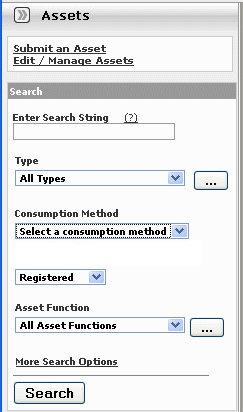
Description of "Figure 1-10 Assets Pane - Consumption Method"
1.4.1.3.2 Filtering More Search Options by Type and/or Registration Status
This procedure is performed in the More Search Options dialog.
Note:
Registration Status is available as a search filtering option only if the Oracle Enterprise Repository Assets in Progress option is activated.
-
Select an appropriate type from the Type list.
-
As necessary, select the appropriate registration status from the Registration Status list.
-
Click Search to run the search without further filtering. Search results are listed in the upper frame of the main pane of the Assets page.
The More Search Options dialog remains open to allow search refinement.
1.4.1.3.3 Filtering More Search Options by Categorizations
This procedure is performed in the More Search Options dialog.
-
Select the appropriate option in the Filter by Categorizations section to locate the search string in Any or All of the selected Categorizations, as shown in Figure 1-11.
-
Select the appropriate check box to determine the categorizations to be searched.
-
Click the + next to any categorization to expand the sub-categorization tree to further refine the search, as shown in Figure 1-12.
-
Click Search to run the search without further filtering. The search results are listed in the upper frame of the main pane of the Assets page.
The More Search Options dialog remains open to allow search refinement.
1.4.1.3.4 Filtering More Search Options by Additional Criteria
This procedure is performed in the More Search Options dialog.
-
Select the Filter by Additional Criteria option. The Filter by Additional Criteria section is displayed, as shown in Figure 1-13.
Figure 1-13 More Search Options Dialog - Filter by Additional Criteria

Description of "Figure 1-13 More Search Options Dialog - Filter by Additional Criteria"
Note that the available options in the Select a Field list are determined by the selections made in Filtering More Search Options by Type and/or Registration Status, as shown in Figure 1-13.
-
Select one of the options listed in the Select a Field list, as shown in Figure 1-14. This action determines the visibility and contents of subsequent lists in the Filter by Additional Criteria section.
Figure 1-14 Filter by Additional Criteria - Asset Functions
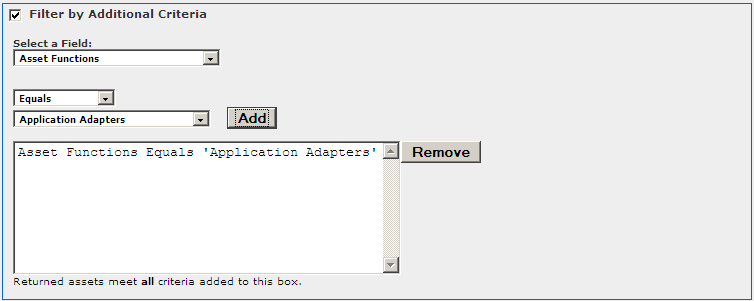
Description of "Figure 1-14 Filter by Additional Criteria - Asset Functions"
-
Select the appropriate additional parameter from the available lists. This selection determines whether an additional list or a text box appears to the left of the Add button.
-
As necessary, enter text in the text box, or select an item from the list.
-
Click Add. The search parameter appears in the large text box.
-
Add additional parameters as necessary.
-
To remove a parameter:
-
Select (single-click) the parameter.
-
Click Remove.
-
-
When the all search parameters have been added, click Search.
Search results appear in the upper frame of the main pane of the Assets page. The More Search Options dialog remains open in the background.
Note:
-
Search criteria remain intact as long as the More Search Options dialog remains open, even when navigating to other areas in Oracle Enterprise Repository.
-
Click the More Search Options link in the sidebar on the Assets page at any time to move the open More Search Options dialog to the foreground, with no change to the criteria established in the current search session.
-
Click Search in the More Search Options dialog at any time to refresh the search results and move the search results display to the foreground.
-
-
If necessary, save the search.
1.4.1.3.5 Searching for Extended Metadata Fields
Certain fields are available for searching on all asset types. These fields are identified by a unique field name, and can be included in criteria for searching for assets of any type. This procedure is performed in the More Search Options dialog.
-
Select the Filter by Additional Criteria option.
-
Select an extended metadata field name, such as
import.informationorinternal.import.summaryfrom the Select a Field list, as shown in Figure 1-15.The optional Enter an XPath field is displayed.
Figure 1-15 Filter by Additional Criteria

Description of "Figure 1-15 Filter by Additional Criteria"
-
An Auto Complete feature assists in the entry of XPaths that correspond to the selected extended metadata field.
For example, an XPath of /
properties/source searches for assets that were submitted to the Repository from Workspace Studio. And an XPath of/properties/sync-datesearches for the date that submission from Workspace Studio occurred. -
When the all search parameters have been added, click Search.
-
If necessary, save the search.
1.4.1.4 Saving Searches
This procedure is performed on the Assets page.
The Saved Searches feature must be activated before searches can be saved.
For more information, see Oracle Fusion Middleware Configuration Guide for Oracle Enterprise Repository.
-
Perform a standard or More Search Options search. The search results appear in the upper frame of the main pane, as shown in Figure 1-16.
-
Click Save This Search. The Save This Search dialog is displayed, as shown in Figure 1-17.
-
Enter the appropriate information in the Name and Description text boxes.
-
Click Submit. The saved search is displayed in the Saved Searches list, as shown in Figure 1-18.
The saved searches are also listed in the Saved Searches section in the My Stuff page, as shown in Figure 1-19.
Figure 1-19 Saved Searches Pane in My Stuff Page

Description of "Figure 1-19 Saved Searches Pane in My Stuff Page"
1.4.1.4.1 Executing a Saved Search
From the Assets page:
-
Select the search to be executed from the Saved Searches list.
-
Click Run Saved Search. The search results are listed in the upper frame of the main pane.
1.4.1.4.2 Managing Saved Searches
These procedures are performed in the Saved Searches section in the My Stuff page.
-
Click the text link for the search to be executed. The search results appear in the upper frame of the main pane on the Assets page.
-
Click Edit next to the saved search. The Save this Search dialog is displayed.
-
Make changes as appropriate to the text in the Name and Description fields. (Search parameters cannot be edited.)
-
Click Save.
-
Select the search option that you want to delete. (Select the Name check box to select ALL saved searches.)
-
Click Delete. The selected search is deleted.
-
Right-click the text link and copy the URL. The browser's dialog is displayed.
-
Use the copied link information to create a direct link to the saved search. The correct syntax is: http://servername/appname/index.jsp?savedsearchid=SEARCHID, where SEARCHID is the ID number of the saved search.
Factors Affecting Search Results
-
Search results may change over time as assets are added to/removed from Oracle Enterprise Repository.
-
Individual search results are subject to user permission settings.
-
Activation of the Assets-in-Progress feature may affect the results of existing Saved Searches.
1.4.1.5 Printing Search Results
(This feature works only in the Internet Explorer browser.)
-
Perform a search. The search results list appears in the upper frame of the Assets page.
-
Click anywhere in the list to select the browser frame.
Option 1:
-
Select Print on the Internet Explorer File menu.
-
Click the Options tab in the Print dialog.
-
Select the Only the selected frame option.
-
Click Print. The document is sent to the printer.
Option 2:
-
Select Print Preview in the Internet Explorer File menu.
-
Select the Only the selected frame option.
-
Click Print. The document is sent to the printer.
-
1.4.1.6 Using EasyLinks
The EasyLink icon is displayed on assets and saved searches, as shown in Figure 1-20. These icons are standard HTML image links that can copied to the clipboard and pasted into documents or email messages as pointers to specific registry artifacts. EasyLinks can also be dragged and dropped onto the desktop.
-
Click the middle icon to display the asset detail.
-
Drag the last icon onto your desktop or into an email or other document to set a link to an asset.
1.4.2 Evaluating Assets
The Asset Detail can be viewed in tabular or frame format. The Asset Detail page provides a wide variety of information on the use, functionality, and history of an asset, as shown in Figure 1-21. Typically, asset metadata is provided by the asset producer and is reviewed by the registrars before presentation through Oracle Enterprise Repository. The information that is captured and displayed can be customized by your organization through the Asset Editor and Type Manager.
After performing an asset search, click any asset listed in the search results to open its Asset Detail in the bottom frame.
Search results on the Asset Search in the Web Console are now limited by default, to improve initial search performance. The number of results is configurable on the Admin | System Properties screen: "cmee.search.assets.maxresults".If a search exceeds the maximum number of results, the search results screen shows a result count like "Results (1000 of 2345)", and a link "Show All" that brings back all of the results.
There are navigation icons in the title area of the asset detail. These icons offer a variety of viewing and navigation options to aid in the evaluation of assets.
-
Click the Hide/Display Search Results icon to expand the Asset Detail, as shown in Figure 1-22. (Click again to restore the search results list in the upper frame.)
-
Click the View Details of This Item in Tabs icon to toggle the Tabbed View mode, as shown in Figure 1-23.
The Tabbed View places the information from each element in the default asset detail on its own tab. When viewing assets of the same type in Tabbed View mode, the selected tab appears for each asset selected from the search results, facilitating easy comparison of asset information. When viewing assets of different types, the selected tab appears only if the assets have the tab in common. Otherwise, the system defaults to the first tab listed in the asset detail.
-
Click the View Next/Previous Item in Search Results icon to navigate to the next or previous asset in the search results.
Within the context of Oracle Enterprise Repository, Affinity is the condition that occurs when two or more assets are deployed in the same project. The Affinity element appears in the asset detail for each asset that meets this condition, and lists other assets that have (deployed) projects in common.
Affinity provides valuable contextual information on asset use.
1.4.2.1 Using the Navigator
The Navigator provides a dynamic graphical representation of the inter-relationships among assets and projects.
For information about activating the Oracle Enterprise Repository Navigator, see "Projects and Navigator" section in Oracle Fusion Middleware Configuration Guide for Oracle Enterprise Repository.
Click the Launch the Navigator icon in the detail display of any asset or project. The Navigator page is displayed, as shown in Figure 1-25.
The upper area of the Navigator presents a dynamic, graphical display of the selected asset and all related assets and projects. The selected asset appears in the center of the upper area of the Navigator display, as indicated by the asset icon within a blue circle. Any related assets and producing (the Producing Projects feature must be enabled) and/or consuming projects are displayed as nodes branching off the center. When a Project is centered, all parent and child projects are displayed, as are all assets produced or consumed by the project.
The lower frame of the Navigator presents the asset's detail, similar to the display on the Assets page.
The Select Relationship menu displays a list of relationships relevant to the in-focus asset, as shown in Figure 1-26.
Click any relationship in the Select Relationship list to view a list of assets or projects bearing the specified relationship to the focus asset. Click any item in that list to move that item to the center of the Navigator display.
Right-click any node in the display to open a menu of display options. The available options are determined by the type of node and its current display state.
-
Enable All Motion
Enables items in the display to be dragged around the window to aid viewing.
-
View Detail
-
Displays the item's detail in the bottom pane.
-
Action can also be toggled by double-clicking the node icon.
-
If you right-click the any node other the node in the centre, the following options are visible to you:
-
Center
Shifts the focus to the selected item, and displays any available related assets or projects. (Does not change the detail display in the bottom pane.) Action can also be toggled by single-clicking the node icon.
-
View Detail
-
Displays the item's detail in the bottom pane.
-
Action can also be toggled by double-clicking the node icon.
-
Double-clicking any relationship node (Depends on, Producing Projects, and so on) expands or collapses the node.
1.4.3 Exporting Asset Details
The Asset Detail frame on the Assets page provides a wide variety of information on the use, functionality, and history of an asset. The asset details on an asset can be exported in any one of the following forms:
1.4.3.1 Exporting Asset Detail to Excel
You can export asset details to an excel file using the following methods:
-
Section 1.4.3.1.1, "Export an Excel File from Search Results"
-
Section 1.4.3.1.2, "Export an Excel file from the Asset Detail"
1.4.3.1.1 Export an Excel File from Search Results
This procedure is performed on the Assets page.
-
Perform an asset search by entering keywords in the Enter Search String text box in the Search section. Use the Type and Asset Function list as necessary to refine the search.
-
Select one or more assets from the search results by placing a check in the check box that appears to the left of assets listed in the Search Results pane, as shown in Figure 1-27.
-
Select Export to Excel in the list at the top of the pane.
Note:
The Export to Excel option is displayed, only when the
cmee.asset.registry.export.excelproperty is enabled. This is enabled by default, but if you are migrating, then you might face an issue if this property is not enabled. -
Click Go. Export progress is indicated in the progress window, with the following options:
-
Click Terminate Job to end the export.
-
Click View Audit Log to open a log of the export process.
-
-
When the export is complete, click View Excel Spreadsheet in the progress window. The spreadsheet opens in Microsoft Excel, as shown in Figure 1-28.
Figure 1-28 Spreadsheet in Microsoft Excel
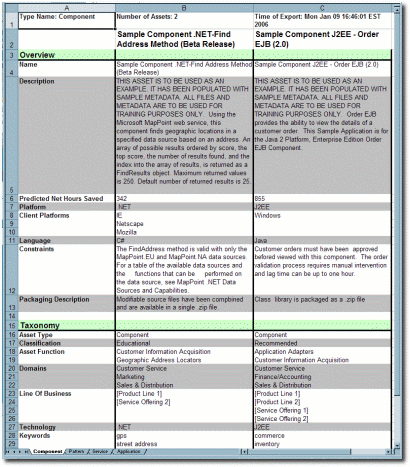
Description of "Figure 1-28 Spreadsheet in Microsoft Excel"
Assets are listed horizontally; Asset Detail elements are indicated by the light-green background (Overview and Taxonomy shown in Figure 1-28).
When assets of multiple types are exported, each type is assigned to a different worksheet tab. Note the following:
-
The specific configuration of each asset type template determines the asset detail elements that are exported to the spreadsheet.
-
System limitations prevent the export of the Relationships, Keywords, Contacts, Reviews, and Usage elements, and of tables, images, or HTML formatting.
-
Limitations in Excel restrict export to no more than 250 assets of the same type during the same export.
-
Note:
To use Export Policies To Excel from Asset Search Results Page, perform the following steps:
-
Log in to
https://support.oracle.com. -
Click the Knowledge tab. The Knowledge Home page is displayed.
-
In the top-right corner of the screen, select Article ID from the Sources list.
-
Enter 952047.1 in the space for entering the article ID number, and click the Browse icon.
The Knowledge Browser window is displayed with this article - Unable to Export Policies To Excel from Asset Search Results Page [ID 952047.1].
1.4.3.1.2 Export an Excel file from the Asset Detail
This procedure is performed on the Assets page.
-
Locate the appropriate asset.
-
Click the Excel icon in the asset detail. Export progress is indicated in the progress window.
-
When the export is complete, click View Excel Spreadsheet in the progress window to open the spreadsheet in Microsoft Excel.
Note:
The specific configuration of each asset type template determines the asset detail elements that are exported to the spreadsheet.
1.4.3.2 Exporting Asset Detail to PDF
This procedure is performed on the Assets page.
Note:
-
Only assets of Types to which an XSLT printing template is associated are available for export to PDF.
-
In the event that the asset selected for export is of a Type to which no printing template is associated, you are notified through a dialog that the export cannot proceed. If multiple assets are selected for export, the dialog lists the Types that cannot be exported. You can then: (a) proceed with the export of any assets of Types with associated printing template, or (b) cancel the export.
-
Notify the registrar of any assets that cannot be exported to PDF.
1.4.3.2.1 Exporting from the Asset Detail Pane
You can export the asset details to PDF from the Asset Detail pane.
-
Use Search or other means to locate the appropriate asset.
-
Click the PDF icon in the asset detail.
-
If prompted to do so, select a printing template from the list.
If the Adobe Acrobat plug-in is installed, the browser opens the PDF. Otherwise, you are prompted to save or open the file.
1.4.3.2.2 Exporting from the Search Results List
-
Perform an asset search by entering keywords in the Enter Search String text box in the Search section.
Use the Type and Asset Function list as necessary to refine the search.
-
Select one or more assets from the search results by placing a check in the check box that appears to the left of assets listed in the Search Results pane.
-
Select Export to PDF from the list above the list of assets.
-
Click Go.
-
If the Adobe Acrobat plug-in is installed, the browser opens the PDF. Otherwise, you are prompted to save or open the file.
1.4.3.3 Exporting Asset Search Results to ZIP
When enabled, the Export to ZIP feature allows the export of asset information to a ZIP file, through a menu selection on the asset search results screen.
-
The Export to ZIP feature is available only to users with Administrator permissions.
-
Import/Export must be enabled. For more information, see Chapter 4, "Import Export Tool".
-
The exported file contains all asset metadata in XML format, including relationships.
This procedure is performed in the Search Results frame on the Assets page.
-
Use Search or other means to locate the asset(s) to be exported to a ZIP file.
-
Use the check boxes in the search results list to select the assets to be exported to ZIP, as shown in Figure 1-29.
-
Select Export to ZIP from the list.
-
Click Go. The Export to ZIP progress dialog is displayed.
-
When the export is complete, click Download to download the exported zip file. The File Download dialog is displayed.
-
Select Open, Save, or Cancel, as appropriate.
1.4.4 Using/Downloading Assets
Using/Downloading an asset enables users to obtain the payload files associated with an asset. For Service assets, the WSDL file might be included as the asset payload. Using/Downloading an asset also initiates asset usage tracking. You have to select the project on which you are using the asset, and the usage is attributed to that project. Email notifications can be initiated after a configurable period of time that ask the user to indicate whether they are still evaluating the asset, have tentatively accepted it for use, or have rejected it.
Perform the following steps to download an asset and its associated files for evaluation.
-
Use Search or other means to locate the asset to be used.
-
Click Use / Download in the asset detail, as shown in Figure 1-30.
The Use - Download page is displayed, as shown in Figure 1-31.
-
Use the Please Choose a Project list to assign the asset to a project (mandatory).
-
Make the appropriate selection in the Subscription check box.
-
As necessary, select any available related assets for inclusion in the download and/or subscription.
-
Click Next. A new dialog is displayed to display the downloadable files in the asset payload.
-
Click the Get File icon. The File Download dialog is displayed.
-
Repeat Steps 7 and 8 as necessary to download other files in the asset payload.
-
When finished, click Close to close the Use - Download dialog.
-
After evaluating the asset, be sure to update the asset's status on the My Stuff page.
1.4.5 Subscribing to Asset Information
Users subscribed to an asset are automatically notified by email if a new version has been created or registered. Manual notification can also be used to communicate any metadata changes to the asset.
-
Use Search or other means to locate an asset.
-
In the Asset window, double-click the asset to display the details of the asset.
-
In the asset details section that appears below the list of assets, click the Subscribe option that appears in the extreme right corner. The Subscribe dialog is displayed.
-
Click the Subscribe button. The asset subscription dialog with the following message is displayed:
Send me information updates about this asset.
-
This option is selected by default, click Close. The asset is added to the list of asset subscriptions on the My Stuff page.
1.4.6 Reviewing Assets
Individuals who have used an asset can provide a written review and a rating for the asset. These reviews are useful to other users, as well as to those who manage the assets. It provides an opportunity for users to share their experiences with others in the community.
Follow these steps to rate an asset and to submit a review.
-
Use Search or other means to locate the asset to be reviewed.
-
Click Submit a Review in the Reviews section of the asset detail. The Submit a Review dialog is displayed, as shown in Figure 1-33.
-
Select the appropriate rating from the Rating list.
-
Enter the appropriate review information in the Comments text box.
-
Click Submit. A confirmation message appears.
-
Close the window, or click here to display the review. The review is now listed on the Reviews tab in the asset detail.
1.4.7 Performing a Standard Asset Submission
This procedure is performed on the Assets page.
-
Click Submit an Asset in the sidebar. The Asset Submission page is displayed, as shown in Figure 1-34.
-
Select the appropriate Type template to apply to the asset from the list in the Overview section, as shown in Figure 1-35.
-
Enter the appropriate information in the Name, Version, and Description text boxes in the Overview section. (Required)
-
Enter the appropriate information in the Comments section. (Optional)
-
As necessary, designate the project that produced the asset by using the >> and << icons to move the appropriate item from the Available Projects to the Selected Projects columns, as shown in Figure 1-36.
-
Enter the URL of the file containing the asset to be submitted in the File's Location URL text box in the File Information section in Figure 1-37.
-
Click Test to validate that the file location URL is correct.
-
(Optional) Alternatively, you can browse for the file to send to the server by clicking the Browse button that appears at the end of the File Upload field. Then, click the Add Attachment Now button.
Note:
You can disable this requirement by entering
cmee.submission.file.required.enableinto the Admin System Settings Search box and set the value to False and click Save. -
When finished, click Submit. The Asset Submission confirmation dialog is displayed, confirming that the asset has entered the asset registration queue.
-
Click Close.
Note:
For information about advanced asset submission and the use of the Asset Editor and the Type Manager, see Oracle Fusion Middleware Configuration Guide for Oracle Enterprise Repository.
1.5 Projects
Projects are the primary means of gathering metrics in Oracle Enterprise Repository. Oracle Enterprise Repository tracks assets produced by projects, as well as assets consumed by projects. Oracle Enterprise Repository users are assigned to projects, and when a user submits a new asset, they are prompted for the producing project. Likewise, when a user wants to reuse an asset, they are prompted for the project on which the asset is reused. This enables Oracle Enterprise Repository to generate reports on the reuse savings per project. It also enables Oracle Enterprise Repository to report on the savings generated by asset production teams. Projects are also hierarchical, which enables organizations to, for example, establish a program that can spawn many projects.
Projects are also a channel for governance practices. Oracle Enterprise Repository Compliance Templates (usually taking the form of Architecture Blueprints or Project Profiles) can be applied to projects.
The Oracle Enterprise Repository Projects page provides access to tools for creating and managing projects, as shown in Figure 1-38.
Figure 1-38 Oracle Enterprise Repository Projects Page

Description of "Figure 1-38 Oracle Enterprise Repository Projects Page"
1.5.1 Viewing Project Details
Project information can be displayed as a series of portlets or tabs.
Project information includes a project description, and indicates the assigned department, start date, estimated hours, and project status.
Displays the Compliance Template(s) assigned to the project, as shown in Figure 1-39.
Lists any assets used in (or under consideration for use in) the project, as shown in Figure 1-40.
Click the Zoom icon next to any listed asset to display its Reported Asset Value.
-
Project members can view the Asset Usage Detail.
-
Project leaders can view/edit the Reported Asset Value.
Figure 1-41 Reported Asset Value of Asset
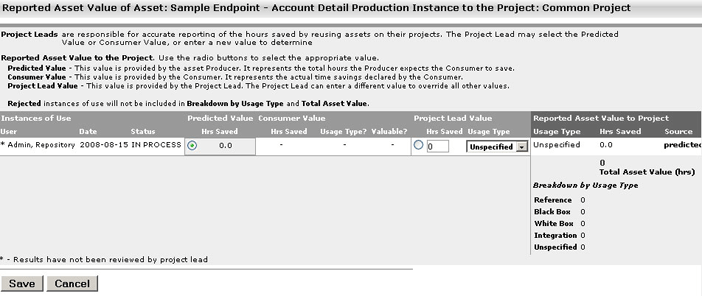
Description of "Figure 1-41 Reported Asset Value of Asset"
-
Reported Asset Value represents the hours saved by reusing assets on their projects. This value is derived from either the Predicted Value, Consumer Value, or a completely new value determined by the project leader. Only the project leader can set this value.
Lists any assets produced by the project, as shown in Figure 1-42.
Lists all users associated with the project, and each user's role on the project (leader/members), as shown in Figure 1-43. Project leaders have the ability to assign a Reported Asset Value value to assets consumed by the project.
When enabled, lists any related projects, and defines the relationships in parent/child terms.
1.6 My Stuff
The My Stuff page provides each user with a personalized Oracle Enterprise Repository home page.
Figure 1-44 Oracle Enterprise Repository Assets Home Page
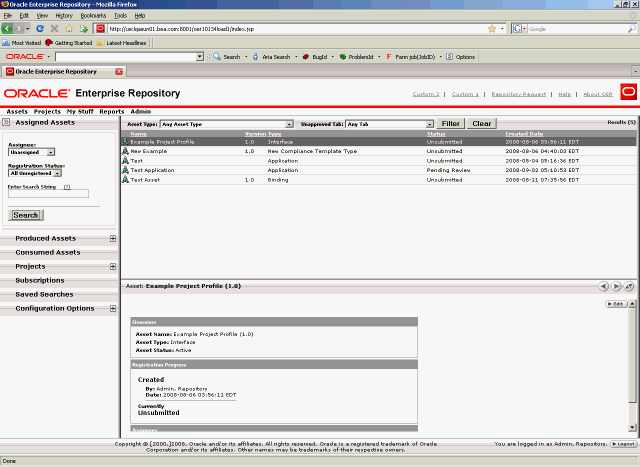
Description of "Figure 1-44 Oracle Enterprise Repository Assets Home Page"
The My Stuff page includes several elements, as described below:
1.6.1 Assigned Assets
Lists all the assets assigned to a user for review and processing as part of the asset registration process. You can base your search for assets by selecting Assignee depending on the options below:
-
Me - Asset that I am assigned to
-
Unassigned - Asset that nobody is assigned to
-
Any Assignee - Asset that somebody is assigned to
You can also base your search for assets on the registration status of an asset. The registration status that can assigned to any asset are as follows:
-
Registered
-
Unregistered
-
All Assets
After you select the values in the Assignee and Registration Status fields, enter a search string in the Enter Search String field and click Search. The result of your search is displayed on right-side of the screen.
1.6.2 Produced Assets
Lists assets that you submitted.
Click any listed asset to:
-
View an asset overview (the asset detail).
-
Edit an asset.
-
If the asset submission was rejected, then you can also resubmit the asset by clicking the Edit button.
The left pane options available are:
-
Submit an Asset: Enables you to submit an asset.
-
Edit / Manage Assets: Enables you to edit or manage an asset that already exists. When you click the Edit / Manage Assets option, the Asset Editor window opens, enabling you to perform the following actions:
-
Configure Acceptable Value Lists
-
Configure Artifact Stores
-
Configure Categorizations
-
Configure Relationships
-
Configure Rejection Reasons
-
Configure Vendors
The Search My Assets pane enables you to list assets according to Registration status. For more information, see Oracle Fusion Middleware Configuration Guide for Oracle Enterprise Repository.
-
1.6.3 Consumed Assets
Lists In-Process assets with a survey status of Still Evaluating and the project to which the asset is associated.
Click any listed asset to:
-
View an asset overview.
-
Submit a review for an asset.
-
Update the status of the survey.
1.6.4 Projects
Lists Closed and Open projects to which the user is assigned. The options available on the left pane are as follows:
-
Create New: Enables the user to create a new project.
-
List All: Lists all the projects that are currently available.
Click any listed project to view the following details:
-
Overview: Describes the general overview of the project that covers Description, the Department it belongs to, other details such as Start Date, Estimated Hours, and Status.
-
Applied Compliance Templates: Describes the compliance templates currently applied to the project.
-
Consumed Assets: Describes the assets consumed or downloaded for this project.
-
Produced Assets: Describes the assets produced for this project.
-
Users: Describes the users assigned for this project. You can also reassign the users by clicking the Reassign Users / Usage option.
-
Related Projects: Describes the projects that are currently related to this project.
1.6.5 Subscriptions
Lists all the asset subscriptions for user notification of updates.
To unsubscribe to an asset, select the asset that you want to unsubscribe and then click the Unsubscribe button. A confirmation dialog opens, click OK.
Click any listed asset to view the asset details. The names and descriptions of the various tabs available are as follows:
-
Apply Policies: Enables you to apply or remove policies from this asset.
-
Notify Subscribers: Enables you to send an email notification to the subscribers of this asset.
-
View Access: Enables you to view the access settings for an asset.
-
Subscribe: Enables you to subscribe to this asset to be notified of any updates.
-
Use - Download: Enables you to use this asset and download any available files.
-
Edit: Enables you to edit the details of this asset.
1.6.6 Saved Searches
Lists all saved searches. This option enables you to search for a particular search and save it for future use.
Click any listed search to display the search results, as shown in Figure 1-45.
To delete a saved search, you must select the saved search, and then click the Delete button.
1.6.7 Configuration Options
Lists all members of the distribution list.
-
Click the Update List button to add or remove list members.
-
Click the Send Email to List button to open an email that is addressed to the list members.
Enables you to change the password to Oracle Enterprise Repository. This has the following fields:
-
Old Password
-
New Password
-
Verify Password
Enter the credentials and click the Change Password button.
1.7 Reports
This section discusses the Oracle Enterprise Repository reports that are available in the Reports page, as shown in Figure 1-47.
Figure 1-47 Oracle Enterprise Repository Reports Page
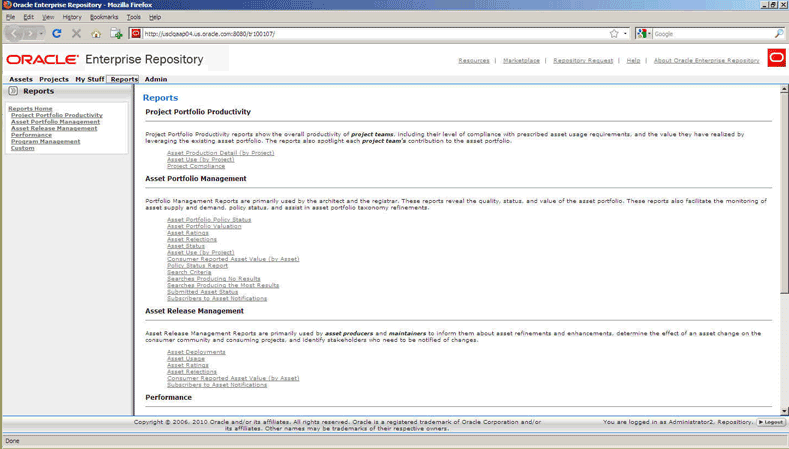
Description of "Figure 1-47 Oracle Enterprise Repository Reports Page"
1.7.1 Report Types
This section describes the Oracle Enterprise Repository report types.
Project Portfolio Productivity Reports
Project Portfolio Productivity reports show the overall productivity of project teams, including their level of compliance with prescribed asset usage requirements, and the value they have realized by leveraging the existing asset portfolio. The reports also spotlight each project team's contribution to the asset portfolio. Project portfolio productivity reports include:
-
Asset Production Detail (by Project) (requires the asset production tracking feature to be enabled)
Shows the individual assets used in a project, as well as the hours saved by using the asset. Managers can use this report to reward groups or individuals for reusing assets; architects and registrars can use the report to spot emerging standards in a portfolio. Managers can also use this report to quantify the value produced for clients.
-
Asset Use (by Project)
Shows individual assets used in a project, as well as the hours saved by using the asset. Managers can use this report to reward groups or individuals for reusing assets; architects and registrars can use the report to spot emerging standards in a portfolio. Managers can also use this report, with project leads, to quantify value produced for clients.
-
Project Compliance (assumes use of Compliance Templates)
Shows the Compliance Templates applied to projects and whether the project is in compliance with the template.
Asset Portfolio Management Reports
Used primarily by architects and registrars, these reports show the quality, status, and value of the asset portfolio. These reports also monitor asset supply and demand, as well as assist with asset portfolio taxonomy refinements. The reports included within this group are as follows:
-
Asset Portfolio Policy Status
Shows a summary of the policy status (pass, fail, unknown) for an organization's entire asset portfolio. The report then enables users to view a list of assets for each status (for example, all of the assets that are failing). The detailed reports list all policies applied to each asset, and the status of all policy assertions.
-
Asset Portfolio Valuation
Shows the number of assets used, how frequently each asset was used and the total savings in reuse time. Architects and registrars can use the report to find the most valuable and valued assets.
-
Asset Ratings
Shows consumer ratings for assets. Architects and registrars can use the report to chart the perceived value of assets, while producers and maintainers can use the report as a feedback mechanism.
-
Asset Rejections
Shows the reasons why an asset was rejected for use in a project. Architects and registrars can use this report to gauge the level of demand for specific assets, while producers and maintainers can use the report as a feedback mechanism.
-
Asset Status
Shows the asset name, type and status (active, inactive, and so on). Registrars can use this report to determine the level of asset lifecycle maintenance required for the asset portfolio.
-
Asset Use (by Project)
Shows individual assets used in a project, as well as the hours saved by using the asset. Managers can use this report to reward groups or individuals for reusing assets; architects and registrars can use the report to spot emerging standards in a portfolio. Managers can also use this report, with project leads, to quantify value produced for clients.
-
Consumer Reported Asset Value (by Asset)
Shows the consumer reported savings associated with an asset, along with the predicted value of the assets. Managers can use this report to refine the numbers used to calculate predicted net hours. Architects and registrars can use this report to identify the most used and valuable assets in the registry. Producers and maintainers can use this report to determine actual asset value as realized by consumers and identify ongoing changes and enhancements to assets in the registry.
-
Policy Status Report
Shows a summary of all policies in an organization's policy portfolio, and the number of assets that are passing, failing, or have an unknown status. This report also shows a detailed list of the assets that are governed by each policy, and the number of assertions that are passing, failing, or have an unknown status.
-
Search Criteria
Shows the number of results of each search parameter. Architects and registrars can use this report to define taxonomies.
-
Searches Producing No Results
Shows the search parameters in a search that produced no results. Ultimately, the report shows areas of unmet demand in the registry. Registrars and architects can use this report to refine taxonomies.
-
Searches Producing the Most Results
Shows the search parameters in searches that returned the most results. This report can be used by architects and registrars to determine if users are finding required information in the registry. The report can also be used to refine taxonomies.
-
Submitted Asset Status
Indicates asset status in the approval cycle. Registrars can use this report to determine scheduling for assets requiring work.
-
Subscribers to Asset Notifications
Shows specific subscribers to asset information. This report can be used by architects and registrars to determine the level of demand on assets in the portfolio.
Asset Release Management Reports
Used primarily by asset producers and maintainers, these reports inform these users about asset refinements and enhancements, determine the effect of an asset change to the consumer community and consuming projects. In addition, these reports identify stakeholders who must be notified about changes. Asset release management reports include:
-
Asset Deployments
Shows the names of deployed assets and the projects with which they are associated. Used by producers, maintainers, and project leads to assess the effect of change to an asset.
-
Asset Usages
Lists the assets selected for use in specific projects. Used by producers, maintainers, and project leads to assess the potential impact of changes to an asset.
-
Asset Ratings
Shows consumer ratings for assets. Architects and registrars can use the report to chart the perceived value of assets, while producers and maintainers can use the report as a feedback mechanism.
-
Asset Rejections
Lists the reasons an asset was rejected for use in a project. Architects and registrars can use this report to gauge the level of demand for specific assets, while producers and maintainers can use the report as a feedback mechanism.
-
Consumer Reported Asset Value (by Asset)
Indicates the consumer reported savings associated with an asset, along with the predicted value of the assets. Managers can use this report to refine the numbers used to calculate predicted net hours. Architects and registrars can use this report to identify the most used and valuable assets in the registry. Producers and maintainers can use this report to determine actual asset value as realized by consumers and identify ongoing changes and enhancements to assets in the registry.
-
Subscribers to Asset Notifications
Shows specific subscribers to asset information. This report can be used by architects and registrars to determine the level of demand on assets in the portfolio.
These reports allow individual users to quantify the value of their contributions to the organization. They also inform department heads about the performance of the producers, consumers, and project leads in their organizations. The performance reports presently included in Oracle Enterprise Repository include:
-
Asset Use (by project)
Shows the assets used in a project, as well as the hours saved by using the asset. Managers can use this report to reward groups or individuals for reusing assets; architects and registrars can use the report to spot emerging standards in a portfolio. Managers can also use this report, with project leads, to quantify value produced for clients.
Used primarily by various managers, these reports expose the value that the program brings to the organization (ROI) and indicates whether the program successfully meets goals, demonstrates program growth and progress and serves as the basis for incentives and governance. The program management reports include:
-
Active and Unapproved User Login
Shows the names of active and unapproved users and the number of times that they logged in. The system administrator or security administrator can use this report to reallocate registry licenses.
-
Active and Unapproved Users with Zero Logins
Shows the names of active and unapproved users who have never logged in. The system administrator or security administrator can use this report to reallocate registry licenses.
-
Asset Portfolio Valuation
Shows the number of assets used, how frequently each asset was used and the total savings in reuse time. Architects and registrars can use the report to find the most valuable and valued assets.
-
Consumer Reported Asset Value (by Asset)
Shows the consumer-reported savings associated with an asset, along with the predicted value of the assets. Managers can use this report to refine the numbers used to calculate predicted net hours. Architects and registrars can use this report to identify the most used and valuable assets in the registry. Producers and maintainers can use this report to determine actual asset value as realized by consumers and identify ongoing changes and enhancements to assets in the registry.
-
Password Event Log
Shows the password changes made for users. The report can be used by security administrators or system administrators to identify security breaches.
-
Submission Status (by Producer)
Shows the names of producers, the number of assets submitted and registered, number of use instances, and the estimated time saved by asset consumers.
-
Subscribers to Asset Notifications
Shows specific subscribers to asset information. This report can be used by architects and registrars to determine the level of demand on assets in the portfolio.
1.7.2 Adding Custom Reports
Oracle Enterprise Repository enables you to add custom reports to the Reports page. All custom Reports must be generated by a reporting engine external to Oracle Enterprise Repository and must be exposed by a URL. On the Reports page, the custom report can be given a name, description, and a link to it.
Caution:
If custom reports are added in this fashion, then the directory containing the reports must be backed up and protected during future upgrades of Oracle Enterprise Repository.
1.7.2.1 Overview
The Oracle Enterprise Repository Reports subsystem is built from a collection of .toc (table of contents), .jod (an XML representation of the internal report GUI), and .xml (Oracle Enterprise Repository Report definition) files. These files reside within the WEBINF/config/reports directory of the Oracle Enterprise Repository web application. To construct a custom report, a .toc file must be modified and a .xml file must be created. The .jod files have nothing to do with this customization and should not be modified.
Oracle provides a custom.toc file for the table of contents beneath the Custom section of the Reports page. A customreports.xml file is also included, and which must be copied and named to something for the report.
1.7.2.2 Configuration Steps
The steps to configure custom reports in Oracle Enterprise Repository are as follows:
-
Browse to the
WEB-INF/config/reportsdirectory for your deployed instance of Oracle Enterprise Repository. -
Copy
customreports.xmlto a new name that represents the report. The extension must be .xml (For example,CustomerReportA.xml). -
Edit
customreports.xmlto name it, describe it, and add a link to the report, as follows:-
The <report> element has a parameter name that must refer to a unique, short name for the report. The file name is recommended (For example,
<report name='CustomerReportA'>). -
The value of the <displayName> element is the label shown in the Reports page within the Custom section (For example,
<displayName>Report A</ displayName>). -
The value of the <description> element is the description shown in the Reports page (For example,
<description>This describes Report A.</description>). -
The value of the <externalLink> element is the URL for the report. This URL should execute the report. (For example,
<externalLink>http://www.example.com/reports/CustomerReportA?cmd=execute</externalLink>).
-
-
Save the copied and modified customreports.xml file into the
WEB-INF/config/reportsdirectory. This is where Oracle Enterprise Repository looks for all report files. The report is now created. -
Edit the
custom.tocfile to add the newly created report to the Reports area of Oracle Enterprise Repository.-
The <report> element specifies the name of the report. Use identical text to what appears in the .xml file for the report. The file name is recommended. (For example,
<report name='CustomerReportA'>)
-
-
Back up the
custom.tocand.xmlfiles for the report. These copies are required after upgrades since the upgrade resets the files. -
Restart the application server.
1.7.3 Running a Report
This procedure is performed on the Reports page. You must install and configure the Oracle Business Intelligence Publisher (BI Publisher) to run a report.
-
Select the report from the list in the sidebar. The report form opens BI Publisher in a new browser window.
-
Login to the BI Publisher using the BI Publisher user name, which is different from the Oracle Enterprise Repository user name.
-
Select parameter values at the top of the report.
-
Click the calendar icon to launch a calendar to select From and To dates. The dates for each report default to a range of Year-To-Date.
-
Select other parameters as appropriate for the report.
-
Select a Sort Order.
-
Click the Template list to select an output format for the report. By default, the HTML template is displayed.
-
Click View. The report is generated.

